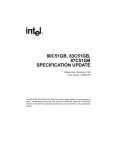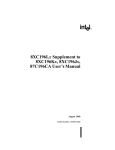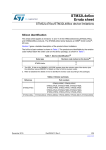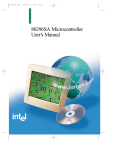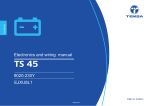Download 88C196EC Microcontroller
Transcript
88C196EC Microcontroller Specification Update October 1998 Notice: The 88C196EC microcontroller may contain design defects or errors known as errata which may cause the product to deviate from published specifications. Current characterized errata are documented in this specification update. Order Number: 273165-003 Information in this document is provided in connection with Intel products. No license, express or implied, by estoppel or otherwise, to any intellectual property rights is granted by this document. Except as provided in Intel’s Terms and Conditions of Sale for such products, Intel assumes no liability whatsoever, and Intel disclaims any express or implied warranty, relating to sale and/or use of Intel products including liability or warranties relating to fitness for a particular purpose, merchantability, or infringement of any patent, copyright or other intellectual property right. Intel products are not intended for use in medical, life saving, or life sustaining applications. Intel may make changes to specifications and product descriptions at any time, without notice. Designers must not rely on the absence or characteristics of any features or instructions marked "reserved" or "undefined." Intel reserves these for future definition and shall have no responsibility whatsoever for conflicts or incompatibilities arising from future changes to them. Contact your local Intel sales office or your distributor to obtain the latest specifications and before placing your product order. Copies of documents which have an ordering number and are referenced in this document, or other Intel literature may be obtained by calling 1-800548-4725 or by visiting Intel’s website at http://www.intel.com. Copyright © Intel Corporation, 1998 *Third-party brands and names are the property of their respective owners. 88C196EC Microcontroller Specification Update Contents Revision History ......................................................................................... 5 Preface....................................................................................................... 6 Summary Table of Changes....................................................................... 7 Identification Information.......................................................................... 10 Errata ........................................................................................................11 Specification Changes ............................................................................. 15 Specification Clarifications ....................................................................... 16 Documentation Changes ......................................................................... 17 88C196EC Microcontroller Specification Update 3 Revision History Date Version Description 11/11/98 08/12/98 003 002 03/16/98 001 Added Errata #20, Stack Overflow Module. Added Errata #18 and #19 and Documentation Changes #25 and #26 This is the new Specification Update document. It contains all identified errata published prior to this date. 88C196EC Microcontroller Specification Update 5 Preface Preface As of July, 1996, Intel’s Computing Enhancement Group has consolidated available historical device and documentation errata into this new document type called the Specification Update. We have endeavored to include all documented errata in the consolidation process, however, we make no representations or warranties concerning the completeness of the Specification Update. This document is an update to the specifications contained in the Affected Documents/Related Documents table below. This document is a compilation of device and documentation errata, specification clarifications and changes. It is intended for hardware system manufacturers and software developers of applications, operating systems, or tools. Information types defined in Nomenclature are consolidated into the specification update and are no longer published in other documents. This document may also contain information that was not previously published. Affected Documents/Related Documents Title Order # 88C196EC CHMOS 16-Bit Microcontroller datasheet (Automotive) 88C196EC Microcontroller User’s Manual 272889 272890 Nomenclature Errata are design defects or errors. These may cause the 88C196EC microcontroller’s behavior to deviate from published specifications. Hardware and software designed to be used with any given stepping must assume that all errata documented for that stepping are present on all devices. Specification Changes are modifications to the current published specifications. These changes will be incorporated in any new release of the specification. Specification Clarifications describe a specification in greater detail or further highlight a specification’s impact to a complex design situation. These clarifications will be incorporated in any new release of the specification. Documentation Changes include typos, errors, or omissions from the current published specifications. These will be incorporated in any new release of the specification. Note: 6 Errata remain in the specification update throughout the product’s lifecycle, or until a particular stepping is no longer commercially available. Under these circumstances, errata removed from the specification update are archived and available upon request. Specification changes, specification clarifications and documentation changes are removed from the specification update when the appropriate changes are made to the appropriate product specification or user documentation (datasheets, manuals, etc.). 88C196EC Microcontroller Specification Update Summary Table of Changes Summary Table of Changes The following table indicates the errata, specification changes, specification clarifications, or documentation changes which apply to the 88C196EC microcontroller product. Intel may fix some of the errata in a future stepping of the component, and account for the other outstanding issues through documentation or specification changes as noted. This table uses the following notations: Codes Used in Summary Table Stepping X: Errata exists in the stepping indicated. Specification Change or Clarification that applies to this stepping. (No mark) or (Blank box): This erratum is fixed in listed stepping or specification change does not apply to listed stepping. (Page): Page location of item in this document. Doc: Document change or update will be implemented. Fix: This erratum is intended to be fixed in a future step of the component. Fixed: This erratum has been previously fixed. NoFix: There are no plans to fix this erratum. Eval: Plans to fix this erratum are under evaluation. Page Status Row Change bar to left of table row indicates this erratum is either new or modified from the previous version of the document. 88C196EC Microcontroller Specification Update 7 Summary Table of Changes Errata Steppings No. A3 B0 B1 Page Status ERRATA B2 1 X 11 Fixed Unable to read EPA/eEPA SFR registers 2 X 11 Fixed PLLEN pin not latched on rising edge of reset 3 X 11 Fixed Flash High-Byte Access 4 X 11 Fixed CS0# Strong Pull-Up Enabled with EA# = 1 5 X 12 Fixed P5.4 Medium Pull-Up Enabled During TROM Execution mode. 6 X 12 Fixed Reset Source CFD Bit 7 X 12 Fixed SCNEN Pin ESD 8 X 12 Fixed eEPA Transmitter 9 X 12 Fixed PIH Lost Interrupts 10 X 12 Fixed V IL Specification Marginality 11 X 12 Fixed NMI Pull-Up Strength 12 X 13 Fixed AD15 Bus Control 13 X X X 13 Fixed Port Initialization 14 X X X X 13 NoFix Odd Uprom Bit Read from TROM 15 X X X X 13 NoFix eEPA Concatenation 16 X X X X 14 NoFix NMIE Interrupt Lost when PIH Interrupt Pending X X X 14 NoFix ICE CS0# Functionality 17 18 X X X X 14 NoFix RSTSRC Register Clear on VCC Power-up 19 X X X X 14 NoFix Reset During Code RAM Read Operation 20 X X X X 14 NoFix Stack Overflow Module Specification Changes Steppings No. Page A3 B0 B1 Status SPECIFICATION CHANGES B2 1 X X X X 15 Doc Flash Program/Erase Temperature Spec 2 X X X X 15 Doc IOH2 Specification X X X 15 Doc PLLEN pin latched on reset 3 Specification Clarifications Steppings No. Page A3 B0 B1 Status SPECIFICATION CLARIFICATIONS B2 None in this revision. 8 88C196EC Microcontroller Specification Update Summary Table of Changes Documentation Changes No. Document Revision Page Status DOCUMENTATION CHANGES 1 User’s Manual 17 Doc Page 6-3, Figure 6-2, Interrupt Service Flow Diagram 2 User’s Manual 17 Doc Page A-20, Table A-6, IDLPD Instruction Definition 3 User’s Manual 18 Doc Page 11-10, Figure 11-5, (AD_COMMAND) Register 4 User’s Manual 18 Doc Page 11-11, Section 11.5, Determining A/D Status and Conversion Results 5 User’s Manual 18 Doc Page 16-1, Figure 16-1, SDU Block Diagram 6 User’s Manual 18 Doc Page 16-3, Figure 16-2, SDU Functional Block Diagram 7 User’s Manual 19 Doc Page 16-6, Section 16.3.3, Minimizing Latency 8 User’s Manual 19 Doc Page 17-22, Section 17.9, Erasing the Flash Memory Block 9 User’s Manual 19 Doc Page C-122, Table C-16, EPA13_TIME SFR 10 User’s Manual 19 Doc Page C-65, Table C-11, Px_DIR Addresses and Reset States 11 User’s Manual 20 Doc Page C-66, Table C-12, Px_MODE Addresses and Reset States 12 User’s Manual 20 Doc Page C-67, Table C-13, Px_PIN Addresses and Reset States 13 User’s Manual 20 Doc Page C-69, Table C-14, Px_REG Addresses and Reset States 14 User’s Manual 20 Doc Pages C-7-8, Table C-2, Register Name, Address, and Reset Value 15 User’s Manual 20 Doc Page 2-20, Figure 2-9, CCR1 Register 16 User’s Manual 20 Doc Page 15-19, Figure 15-7, CCR1 Register 17 272889 21 Doc Page 18, Section 6.0, Electrical Characteristics 18 272889 21 Doc Page 18-19, Table 6.1, DC Characteristics 19 User’s Manual 21 Doc Page 9-22, Section 9.5.1, Consistent MSB bit length procedure in SSIO 20 User’s Manual 21 Doc Page 10-28, Figure 10-21, Timer x Control (TxCONTROL) Register A/D Command 21 User’s Manual 21 Doc Page 10-7, Figure 10-2, EPA Timer/Counters 22 User’s Manual 22 Doc Page 10-15, Figure 10-7, EPAPWM Receive/Transmit Channel 23 User’s Manual 22 Doc Page 10-24, Section 10.7, Generating a 32-Bit Time Value 24 User’s Manual 22 Doc Page 10-38, Figure 10-25, EPAPWMx Control Register 25 User’s Manual 22 Doc Page 13-13 Figure 13-11, RSTSRC Register 26 User’s Manual 22 Doc Page C-86, RSTSRC Register 88C196EC Microcontroller Specification Update 9 Identification Information Identification Information Markings Bottom mark: NG88C196EC 10 88C196EC Microcontroller Specification Update Errata Errata 1. Unable to read EPA/eEPA SFR registers Problem: During a read of the EPA and eEPA SFR registers, there was contention found in the data bus that these two modules share. This contention caused the values in both the EPA and eEPA registers to be read simultaneously. Therefore, the data was invalid. Implication: Affected applications that read from these registers. Status: Fixed. Refer to Summary Table of Changes to determine the affected stepping(s). 2. PLLEN pin not latched on rising edge of reset Problem: The target specification for this device stated that “the state of the PLLEN pin is latched at the rising edge of reset. Thus, any transitions during operation will have no effect upon the PLL.” The A-3 silicon did not contain the necessary logic to behave in this manner. Implication: Noisy applications could cause the PLLEN pin to switch states during execution. Status: Fixed. Refer to Summary Table of Changes to determine the affected stepping(s). 3. Flash High-Byte Access Problem: Odd addresses in the Flash could not be accessed. This is because the block lock bits which control access to the Flash are only read by the even byte sense amps. When programming, erasing, or executing a flash function the lock bits are read first. If the address of the function to be performed was an odd address then the odd byte sense amps were used so the lock bits were not accessed and the read from the even byte sense amps returned a logic “1”. This caused the device to think the block lock bits were programmed which disabled the Flash functions. Implication: Unable to run code from on-chip Flash. Workaround: Use external memory option. Status: Fixed. Refer to Summary Table of Changes to determine the affected stepping(s). 4. CS0# Strong Pull-Up Enabled with EA# = 1 Problem: The CS0# pin had a strong pull-up enabled when running internally and from test ROM execution mode. Implication: A strong driver is needed to overdrive CS0# to a low voltage level to allow entry into certain test ROM execution modes including: SIO RISM mode, Auto Programming mode, Slave Dump/ Programming mode, and Uprom Dump/Programming mode. Workaround: Provide a strong driver in application to overdrive the CS0# pin to a low voltage. Status: Fixed. Refer to Summary Table of Changes to determine the affected stepping(s). 88C196EC Microcontroller Specification Update 11 Errata 5. P5.4 Medium Pull-Up Enabled During TROM Execution mode. Problem: The P5.4 pin had a medium pull-up enabled when executing from test ROM execution mode. Implication: A strong driver is needed to overdrive P5.4 to a low voltage to enter all test ROM execution modes excluding SDU mode. Workaround: Provide strong driver in application to overdrive the P5.4 pin to a low voltage. Status: Fixed. Refer to Summary Table of Changes to determine the affected stepping(s). 6. Reset Source CFD Bit Status: The CFD bit was not correctly set in the reset source SFR register. The bit was set to a “1” even though a reset due to the oscillator fail detect circuitry did not occur. This problem occurred when the power supply ramp from 0 V to 5 V was too fast. Implication: Affects applications that use the CFD bit to determine application flow. Since nodes ND1 and PURS control reset signals which in turn control many different functions in the device, other application uses may also be adversely affected. Workaround: Add external capacitors to the VCC supply to slow the voltage ramp from 0 V to 5 V. Status: Fixed. Refer to Summary Table of Changes to determine the affected stepping(s). 7. SCNEN Pin ESD Problem: The SCNEN pin did not meet Intel’s qualification requirements for ESD protection. Implication: The SCNEN pin was sensitive to ESD. Status: Fixed. Refer to Summary Table of Changes to determine the affected stepping(s). 8. eEPA Transmitter Problem: An eEPA would not reset its associated pin if a match within the same eEPA occurred “simultaneously”. Implication: eEPA events may be missed. Status: Fixed. Refer to Summary Table of Changes to determine the affected stepping(s). 9. PIH Lost Interrupts Problem: When a read from the PIH interrupt pending register occurred at the same time as an incoming interrupt, the new interrupt was lost. Implication: Interrupts may be lost. Status: Fixed. Refer to Summary Table of Changes to determine the affected stepping(s). 10. VIL Specification Marginality Problem: VIL was marginal to target specifications causing yield fallout. Implication: Device may not work with other devices depending on how clean their input low signal is. Status: Fixed. Refer to Summary Table of Changes to determine the affected stepping(s). 11. NMI Pull-Up Strength Problem: NMI Pull-Up Strength was not strong enough to meet target specifications. Implication: NMI pin could cause an interrupt by going low due to weak pull-up. Status: Fixed. Refer to Summary Table of Changes to determine the affected stepping(s). 12 88C196EC Microcontroller Specification Update Errata 12. AD15 Bus Control Problem: Address Data pin 15 may intermittently fail after the execution of a Ljmp instruction. This pin may be read as a one instead of a zero because of a glitch that occurs when the pin output driver is turned off. The glitch is caused by the data changing before the output driver is completely turned off. The AD15 pin is the farthest pin from the driving logic. Under extreme conditions, the AD14 pin may also fail. Implication: May affect applications that use the Ljmp instruction. Status: Fixed. Refer to Summary Table of Changes to determine the affected stepping(s). 13. Port Initialization Problem: Depending on which phase the device is brought out of reset, a race condition may occur between the reset signal and the data input into the port SSEL and DIR registers. This affects ports 2, 6, 7, 8, and 9. Instead of the registers being initialized to their default reset settings, they may get initialized to whatever was last on the internal PDB. Implication: May affect applications that depend on the pins on these ports to come up in their defined reset state. Status: Fixed. Refer to Summary Table of Changes to determine the affected stepping(s). 14. Odd Uprom Bit Read from TROM Problem: The test ROM code used to read the status of the “Uprom” bits utilizes the Cobra FACE commands. The Cobra FACE command for reading the “Uprom” (or block lock bit) status outputs the status on AD0. However, the bus controller only outputs AD8-AD15 when reading from odd addresses. Therefore, when accessing the odd block lock bit addresses (Uprom bits DEI and CLK1), the status will always read as “programmed” regardless of the state of the bits. Implication: May affect applications that program and verify the Uprom bits DEI and CLK1. Workaround: Read the UPROM Special Function Register (1FF6h) to determine the status of the Uprom bits. (Refer to 88C196EC Microcontroller User’s Manual, P. 17-40.) Status: NoFix. Refer to Summary Table of Changes to determine the affected stepping(s). 15. eEPA Concatenation Problem: In the EPAPWM control registers (figure 10-25 in User’s Manual), bit 0 is defined as the Enable Module Concatenation bit. This feature does not work on the device. This bit should be set to a “0”. Status: NoFix. Refer to Summary Table of Changes to determine the affected stepping(s). 88C196EC Microcontroller Specification Update 13 Errata 16. NMIE Interrupt Lost when PIH Interrupt Pending Problem: When a PIH interrupt is pending, a NMIE interrupt will not be serviced. Instead, the pending PIH interrupt will be serviced even if it is globally disabled. Implication: Interrupts will be incorrectly serviced under above described conditions. Affects in-circuit emulator designs only. Status: NoFix. Refer to Summary Table of Changes to determine the affected stepping(s). 17. ICE CS0# Functionality Problem: CS0# functionality is disabled while in ICE mode. Implication: CS0# pin cannot be emulated on emulator. Status: NoFix. Refer to Summary Table of Changes to determine the affected stepping(s). 18. RSTSRC Register Clear on VCC Power-up Status: The four least-significant bits in the RSTSRC register (CFDRST, WDTRST, SFWRST, and EXTRST) are supposed to be cleared when VCC is powered up. The CFDRST, WDTRST, and SFWRST bits may be erroneously set on VCC power-up and cannot be guaranteed to be cleared. Implication: Applications that rely on these bits to be cleared on VCC power-up may be adversely affected. Status: NoFix. Refer to the Summary Table of Changes to determine the affected stepping(s). 19. Reset During Code RAM Read Operation Problem: During the time that the device is reading data from code RAM, a code RAM corruption may occur if: • a device reset occurs from a falling edge on the RESET# pin • a watchdog time-out event occurs or • a clock fail detect event occurs Implication: Code RAM data corruption may occur as a result of the reset event. Workaround: If code RAM data integrity must be maintained after the reset event, prevent external resets, watchdog time-out events, and clock fail detect events from occurring during a code RAM read operation Status: NoFix. Refer to Summary Table of Changes to determine the affected stepping(s). 20. Stack Overflow Module Problem: Writing an address to location 001C18h in the Upper Register File that is less than or equal to the lower stack boundary (STACK_BOTTOM) or greater than or equal to the upper boundary (STACK_TOP) generates a stack overflow interrupt. Implication: Inadvertent stack overflow interrupts may occur during normal code execution. Status: NoFix. Refer to the Summary Table of Changes to determine the affected stepping(s). 14 88C196EC Microcontroller Specification Update Specification Changes Specification Changes 1. Flash Program/Erase Temperature Spec Issue: Operating temperature specifications for programming and erasing the on-chip Flash on the 88C196EC has been changed from -40°C – 125 °C to 0°C – 70 °C. Implication: Intel does not guarantee that the Flash programming and erasing capabilities will function correctly above 70°C and below 0 °C. Affected Docs: 88C196EC CHMOS 16-Bit Microcontroller datasheet - 272889 2. IOH2 Specification Issue: The IOH2 specification has been changed in the following manner: • Old -30 µA to -120 µA (VOH2 = VCC - 1.0 V) -75 µA to -240 µA (VOH2 = VCC - 2.5 V) -90 µA to -280 µA (VOH2 = VCC - 4.0 V) • New -30 µA to -140 µA (VOH2 = VCC - 1.0 V) -65 µA to -280 µA (VOH2 = VCC - 2.5 V) -75 µA to -350 µA (VOH2 = VCC - 4.0 V) Affected Docs: 88C196EC CHMOS 16-Bit Microcontroller datasheet - 272889 3. PLLEN pin latched on reset Issue: On the 88C196EC A-step, the PLLEN pin was not latched on reset. On the B-step, a latch was added to the PLLEN pin so that the state of the PLL can only be changed at the time of reset. Affected Docs: 88C196EC Microcontroller User’s Manual 88C196EC Microcontroller Specification Update 15 Specification Clarifications Specification Clarifications None for this revision of the specification update. 16 88C196EC Microcontroller Specification Update Documentation Changes Documentation Changes 1. Page 6-3, Figure 6-2, Interrupt Service Flow Diagram Issue: Interrupt service flow diagram is incorrect. A normal interrupt will not be serviced if the PTSSEL.x bit is set to 1. To make correct, the following change needs to be made: Add “PTSSEL.x bit = 0?” conditional branch after yes branch of “Interrupts Enabled?” If conditional answer is “yes,” continue to “priority resolver” block. If conditional answer is “no,” then continue to “return”. Affected Docs: 88C196EC Microcontroller User’s Manual 2. Page A-20, Table A-6, IDLPD Instruction Definition Issue: Illegal key definition is incorrect. Key = 3 is not considered an illegal key by the device and will not cause the device to reset. Only keys greater than 3 are considered illegal. Old Definition: IDLE/POWERDOWN. Depending on the 8-bit value of the KEY operand, this instruction causes the device to: • enter idle mode, if KEY = 1, • enter powerdown mode, if KEY = 2, • execute a reset sequence, if KEY = any value other than 1 or 2. The bus controller completes any prefetch cycle in progress before the CPU stops or resets. If KEY = 1 then enter idle else if KEY = 2 then enter powerdown else execute reset PSW Flag Settings Z N C V VT ST — — Key = 1 or 2 — — — — Key = any value other than 1 or 2 0 0 0 0 0 0 88C196EC Microcontroller Specification Update 17 Documentation Changes • New Definition: IDLE/POWERDOWN. Depending on the 8-bit value of the KEY operand, this instruction causes the device to: enter idle mode, if KEY = 1, enter powerdown mode, if KEY = 2, execute a reset sequence, if KEY = any value greater than 3. The bus controller completes any prefetch cycle in progress before the CPU stops or resets. If KEY = 1 then enter idle else if KEY = 2 then enter powerdown else if KEY > 3 then execute reset PSW Flag Settings Z N C V VT ST — — Key = 1 or 2 — — — — Key = any value greater than 3 0 0 0 0 0 0 Affected Docs: 88C196EC Microcontroller User’s Manual 3. Page 11-10, Figure 11-5, A/D Command (AD_COMMAND) Register Issue: Added sentence to “GO bit” note: “GO bit must be set to 0 for A/D SCAN to work.” Affected Docs: 88C196EC Microcontroller User’s Manual 4. Page 11-11, Section 11.5, Determining A/D Status and Conversion Results Issue: The last sentence of the first paragraph is incorrect. • Old: “If you read the AD_RESULT or AD_RESULTx before the conversion is complete, the result is not guaranteed to be accurate.” • New: “If you read the AD_RESULT register before the conversion is complete, the result is not guaranteed to be accurate. The AD_RESULTx register can be read at any time.” Affected Docs: 88C196EC Microcontroller User’s Manual 5. Page 16-1, Figure 16-1, SDU Block Diagram Issue: Code RAM size in SDU block diagram is incorrect. The diagram should specify 2.75 Kbytes of Code RAM, not 3 Kbytes. Affected Docs: 88C196EC Microcontroller User’s Manual 6. Page 16-3, Figure 16-2, SDU Functional Block Diagram Issue: Code RAM size and Test ROM size in SDU Functional Block Diagram is incorrect. The diagram should specify 2.75 Kbytes of Code RAM, not 3 Kbytes and 4 Kbytes of Test ROM, not 1 Kbyte. Affected Docs: 88C196EC Microcontroller User’s Manual 18 88C196EC Microcontroller Specification Update Documentation Changes 7. Page 16-6, Section 16.3.3, Minimizing Latency Issue: Entire section is not worded correctly. • Old: The issue of latency arises when the SDU starts a cycle and the bus controller wants to use the code RAM in the next state. If any user application is executing from code RAM when the SDU is attempting to access the code RAM, you will incur a significant performance decline in your code RAM accesses. Even if the bus controller is idle, the SDU cannot access the code RAM without some small effect. Because accesses to the code RAM by the SDU require at least two CPU state times, it is necessary to understand what the bus controller is doing at all times to ensure that any latency will be minimized. • New: The SDU can only access the code RAM when the bus controller is starting an access to memory other than code RAM (i.e., Flash or external memory). Accesses to register RAM do not count in most cases since the CPU directly accesses the register file. Therefore, it is necessary to understand what the bus controller is doing in the user application at all times to minimize latency. Affected Docs: 88C196EC Microcontroller User’s Manual 8. Page 17-22, Section 17.9, Erasing the Flash Memory Block Issue: The second paragraph in section 17.9 is incorrect. P2.0 does not go low if an erase failure occurs. • Old: “The erase routine has the effect of driving pin P2.6 to a “logic 0” if the erase failed, and driving pin P2.0 to a “logic 0” for a period of 15 state times.” • New: “The erase routine has the effect of driving pin P2.6 to a “logic 0” if the erase failed.” Affected Docs: 88C196EC Microcontroller User’s Manual 9. Page C-122, Table C-16, EPA13_TIME SFR Issue: Register location for EPA13_TIME is incorrect. The correct location is 1F3Eh. • Old: Register Mnemonic Memory Location 32-Byte WSR Windows Direct Address 64-Byte WSR Windows Direct Address 128-Byte WSR Windows Direct Address EPA13_TIME 1F2Ah 79H EAH 3CH EAH 1EH AAH Register Mnemonic Memory Location 32-Byte WSR Windows Direct Address 64-Byte WSR Windows Direct Address 128-Byte WSR Windows Direct Address EPA13_TIME 1F3Eh 79H FEH 3CH FEH 1EH BEH • New: Affected Docs: 88C196EC Microcontroller User’s Manual 10. Page C-65, Table C-11, Px_DIR Addresses and Reset States Issue: P6_DIR register address is incorrect. It should be 1FE3h, not 1FD3h. Affected Docs: 88C196EC Microcontroller User’s Manual 88C196EC Microcontroller Specification Update 19 Documentation Changes 11. Page C-66, Table C-12, Px_MODE Addresses and Reset States Issue: P6_MODE register address is incorrect. It should be 1FE1h, not 1FD0h. Affected Docs: 88C196EC Microcontroller User’s Manual 12. Page C-67, Table C-13, Px_PIN Addresses and Reset States Issue: P6_PIN register address is incorrect. It should be 1FE7h, not 1FD7h. Affected Docs: 88C196EC Microcontroller User’s Manual 13. Page C-69, Table C-14, Px_REG Addresses and Reset States Issue: P6_REG register address is incorrect. It should be 1FE5h, not 1FC4h. Affected Docs: 88C196EC Microcontroller User’s Manual 14. Pages C-7-8, Table C-2, Register Name, Address, and Reset Value Issue: The following register addresses need to be corrected: P6_DIR should be 1FE3h, not 1FD3h P6_MODE should be 1FE1h, not 1FD0h P6_PIN should be 1FE7h, not 1FD7h P6_REG should be 1FE5h, not 1FC4h Affected Docs: 88C196EC Microcontroller User’s Manual 15. Page 2-20, Figure 2-9, CCR1 Register Issue: CFD bit definition is incorrect. The enable and disable bits are reversed. • Old: 0 = enables clock-failure detection circuitry 1 = disables clock-failure detection circuitry • New: 0 = disables clock-failure detection circuitry 1 = enables clock-failure detection circuitry Affected Docs: 88C196EC Microcontroller User’s Manual 16. Page 15-19, Figure 15-7, CCR1 Register Issue: CFD bit definition is incorrect. The enable and disable bits are reversed. • Old: 0 = enables clock-failure detection circuitry. 1 = disables clock-failure detection circuitry. • New: 0 = disables clock-failure detection circuitry. 1 = enables clock-failure detection circuitry. Affected Docs: 88C196EC Microcontroller User’s Manual 20 88C196EC Microcontroller Specification Update Documentation Changes 17. Page 18, Section 6.0, Electrical Characteristics Issue: Added Note 4 to TC under Operating Conditions. Note 4 states “Flash programming and erase operations only guaranteed to work from 0°C to +70 °C”. Affected Docs: 88C196EC CHMOS 16-Bit Microcontroller datasheet - 272889. 18. Page 18-19, Table 6.1, DC Characteristics Issue: Changed the following DC Characteristic Parameters: 1. IPD: Typical changed from 20 µA to 50 µA. Max value no longer specified. 2. IOH2 Max with VOH2 = VCC - 1.0 V changed from -120 µA to -140 µA. 3. IOH2 Min with V OH2 = V CC - 2.5 V changed from -75 µA to -65 µA. 4. IOH2 Max with VOH2 = VCC - 2.5 V changed from -240 µA to -280 µA. 5. IOH2 Min with V OH2 = V CC - 4.0 V changed from -90 µA to -75 µA. 6. IOH2 Max with VOH2 = VCC - 4.0 V changed from -280 µA to -350 µA. Affected Docs: 88C196EC CHMOS 16-Bit Microcontroller datasheet - 272889 19. Page 9-22, Section 9.5.1, Consistent MSB bit length procedure in SSIO Issue: Inserted “Disable Interrupts” between steps 1 and 2 in procedure for achieving a consistent MSB bit length. Affected Docs: 88C196EC Microcontroller User’s Manual 20. Page 10-28, Figure 10-21, Timer x Control (TxCONTROL) Register Issue: UD bit description incorrectly states that the T2CONTROL direction bit controls the direction of both timers 1 and 2 when in concatenation mode. T1CONTROL direction bit actually controls the direction of both timers 1 and 2 when in concatenation mode. • Old: If T2CONTROL.7 is set, this bit in T2CONTROL controls the direction of both timers 2 and 1. • New: If T2CONTROL.7 is set, this bit in T1CONTROL controls the direction of both timers 2 and 1. Affected Docs: 88C196EC Microcontroller User’s Manual 21. Page 10-7, Figure 10-2, EPA Timer/Counters Issue: When timer concatenation is enabled, the OVRTM1 signal from timer 1 does not go through the timer 2 prescalar module. To fix the diagram, the 2x1 multiplexer for T2CONTROL.7 should be switched with the Prescalar module. The input to the prescalar module will now be the output from the 2x1 multiplexer for T2CONTROL.4:3 and the output will go into the 2x1 multiplexer for T2CONTROL.7 along with the OVRTM1 signal. The output of the 2x1 multiplexer for T2CONTROL.7 will go to clock. Affected Docs: 88C196EC Microcontroller User’s Manual 88C196EC Microcontroller Specification Update 21 Documentation Changes 22. Page 10-15, Figure 10-7, EPAPWM Receive/Transmit Channel Issue: EEPA concatenation does not function on 88C196EC. Dotted line entitled “Concatenate” connecting EN_EPAx_CON to EPAPWM pin should be deleted in Figure 10-7. Affected Docs: 88C196EC Microcontroller User’s Manual 23. Page 10-24, Section 10.7, Generating a 32-Bit Time Value Issue: EEPA concatenation does not function on the 88C196EC. Remove last sentence in first paragraph on section 10.7, “You can also use timers 1 and 2 and any pair of adjacent EPAPWM channels in this same manner.” Affected Docs: 88C196EC Microcontroller User’s Manual 24. Page 10-38, Figure 10-25, EPAPWMx Control Register Issue: EEPA concatenation does not function on the 88C196EC. Change bit 0 definition of EPAPWMx Control register from EMC to Reserved bit. “EMC” in column 2 will change to “-“. Column 3 should change to “Reserved; always write as zero.” Affected Docs: 88C196EC Microcontroller User’s Manual 25. Page 13-13 Figure 13-11, RSTSRC Register Issue: The reset state of register is not 00h. It is xxh. • Old Reset state: 00h • New Reset state: xxh Affected Docs: 88C196EC Microcontroller User’s Manual 26. Page C-86, RSTSRC Register Issue: The reset state of register is not 00h. It is xxh. • Old Reset state: 00h • New Reset state: xxh 22 88C196EC Microcontroller Specification Update






















